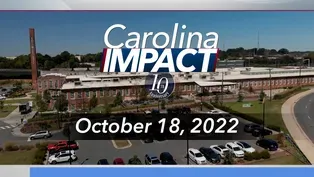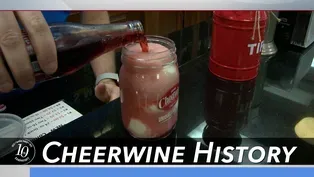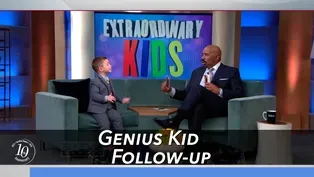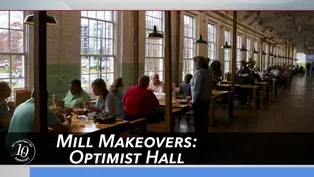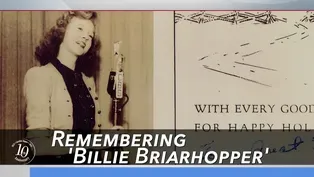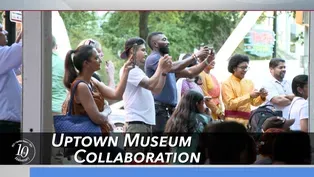
Carolina Impact: October 18, 2022
Season 10 Episode 5 | 27m 25sVideo has Closed Captions
Mill Makeovers - Optimist Hall, Cheerwine, Genius Kid, Uptown Museums, Billie Briarhopper
Mill Makeovers - Optimist Hall, Cheerwine, Genius Kid, Uptown Museums, Billie Briarhopper
Problems with Closed Captions? Closed Captioning Feedback
Problems with Closed Captions? Closed Captioning Feedback
Carolina Impact is a local public television program presented by PBS Charlotte

Carolina Impact: October 18, 2022
Season 10 Episode 5 | 27m 25sVideo has Closed Captions
Mill Makeovers - Optimist Hall, Cheerwine, Genius Kid, Uptown Museums, Billie Briarhopper
Problems with Closed Captions? Closed Captioning Feedback
How to Watch Carolina Impact
Carolina Impact is available to stream on pbs.org and the free PBS App, available on iPhone, Apple TV, Android TV, Android smartphones, Amazon Fire TV, Amazon Fire Tablet, Roku, Samsung Smart TV, and Vizio.
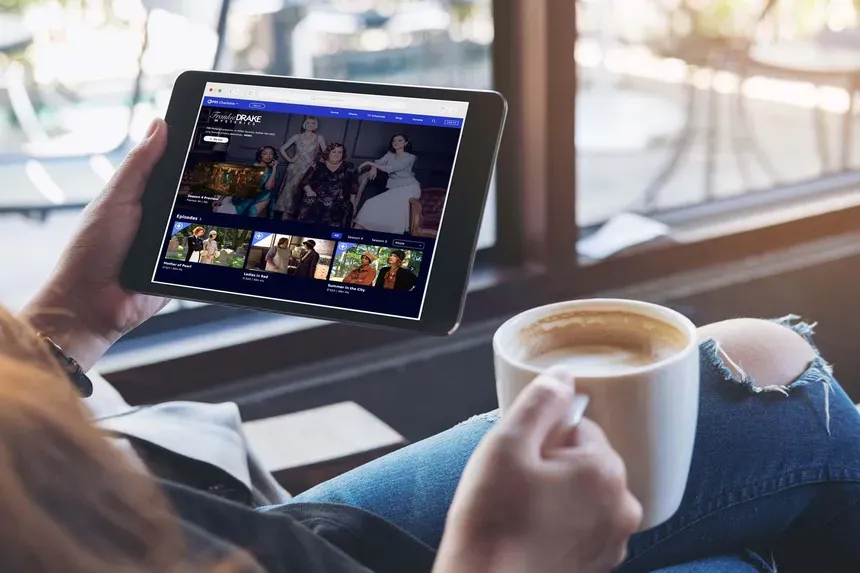
Introducing PBS Charlotte Passport
Now you can stream more of your favorite PBS shows including Masterpiece, NOVA, Nature, Great British Baking Show and many more — online and in the PBS Video app.Providing Support for PBS.org
Learn Moreabout PBS online sponsorship- [Announcer] This is a production of PBS Charlotte.
- Just ahead on Carolina Impact.
- Charlotte's mill makeovers then and now.
I'm Jeff Sonier.
We'll take you back to what some of these old textile mills looked like before their successful redevelopment today.
- Plus, we'll learn how uptown Charlotte museums are encouraging visitors to return, and we'll learn the history of a Tar Heel favorite, Cheerwine.
Carolina Impact starts right now.
- [Announcer] Carolina Impact, covering the issues, people and places that impact you.
This is Carolina Impact.
(exciting music) - Good evening.
Thanks so much for joining us.
I'm Amy Burkett.
The textile mills that used to anchor some of Charlotte's oldest neighborhoods 100 years ago are making a comeback.
They're part of Charlotte's living history, and now also part of our future after a series of mill makeovers that we first reported on five years ago.
As we celebrate Carolina Impact's 10th anniversary, we're revisiting some of those mill makeovers.
Carolina Impact's Jeff Sonier and videographer Doug Stacker take us back to Optimist Hall to see what a difference a few years can make.
- Yeah, last time we were here at Optimist Hall, there were lots of reasons not to be optimistic at all about the huge success that this mill makeover project enjoys today.
♪ Got the cotton mill blues ♪ Got the cotton mill blues ♪ Got the cotton mill blues on my mind ♪ - The building was in shambles.
-[Jeff] Developer Erik Johnson remembers Optimist Hall before it was Optimist Hall.
In 2017, this unfinished project was called Tompkins Hall.
Different name, but the same old mill with a leaky roof that had to go, and these creaky floorboards down below.
♪ Got the cotton mill blues ♪ Got the cotton mill blues - [Jeff] Back then, on a scale of one to 10, we asked construction supervisor Cliff Brown how bad was it.
- This is probably a nine.
- Wow.
- This is a difficult project.
Once you peel it all apart, you start to see really the extent of the damage.
- Yeah, there was even a tree in the smoke stack of what used to be Highland Mill Number One, built in 1892.
♪ Got the cotton mill blues - [Jeff] When Charlotte's skyline was mostly smokestacks.
♪ Got the cotton mill blues on my mind ♪ - You've always got to be optimistic as a developer, but we sat down and we said man, what are we doing?
And I think one of those times was probably after we watched your interview with Cliff and he talked about how challenging the construction was on a scale of one to 10.
- [Jeff] But Johnson says that was then, and this is now.
No cotton mill blues anymore.
- This is what we had hoped for, is that you could come here and just enjoy a good meal and a good time and potentially meet some new people.
I think from that standpoint, we've been successful.
- [Jeff] At Optimist Hall today, success is measured by the never-empty tables inside and the always-filled parking lot outside, all at a factory-turned-food hall where the tall glass and exposed brick are still there, everywhere, giving you that feeling floor to ceiling that you're revisiting part of Charlotte's history.
- These are the original windows from some of the original buildings.
- And you repurposed them as dividers.
- Yeah, we said we've got a lot of interesting memorabilia.
We should try to utilize that.
And these as an example, were the waste receptacles for the hosiery manufacturing process.
- Really?
But still, if you drove through this neighborhood 10 years ago, I'm not sure anybody would ever have seen this as a destination that it is today.
- Yes, and if you look at this area in particular, we call it the mill district.
There's all these mills that are right in the light rail because those buildings that were old, they had a lot of character, tenants want to be there.
- [Jeff] And not just any tenants, either.
Here at Optimist Hall, these are all local and regional restaurants, small restaurant owners, even some new restaurant owners, but not new to the restaurant business.
- Maybe they were the chef or maybe they did it out of a food truck.
They can come in and they can be very successful, make money for themselves, employ a bunch of people.
And those are the types of businesses people generally want to support.
(soft music) - We're stationary.
Wheels off, everyone knows where we're at.
We have a big following on social media.
- [Jeff] Jason Aleman is general manager of Papi Queso, a popular stop on Charlotte's food truck scene for 10 years.
Papi Queso now also serving up their same great grilled cheese and these rosemary fries to hungry customers here at Optimist Hall, where Papi Queso's restaurant is decorated with dozens of old food truck mirrors.
- Yeah, that was beautiful.
We liked the whole concept of Optimist Hall, just community, and we're like a family because they came where we came from so they know the trials and tribulations, the opportunities that they had to overcome.
And then coming here and being welcome with open arms.
It could be challenging sometimes, but we have to, and not trying to be punny, have to remain optimistic.
Have to remain optimistic.
- [Jeff] Yep, another optimist at Optimist Hall where you've seen the public food hall side.
So now how about a peek at the other side that you haven't seen, right through this decorated door.
This is Duke Energy's Innovation Center at Optimist Hall, with wide open space for hundreds of Duke employees to create and collaborate.
It's a factory for new ideas in an actual Charlotte factory.
These stacks of old creaky boards are now polished wood floors.
The old mill's original brick and beam are still standing, too.
A century old building and a century old company both looking to the future.
- I've been in Optimist since we opened the doors.
- [Jeff] Richard Donaldson is Duke's VP for digital transformation, talking with us about Duke Energy's transformation at Optimist Hall.
- You know, we needed people to feel like they could spread their wings and think a little differently.
- [Jeff] You were in the uptown high rises before.
How different is it coming to a building like this?
- Very, very different.
It's an adjustment, but the adjustment happened fast, so people went from apprehension to they couldn't wait to get out here.
I couldn't have imagined the difference it made.
Enormous draw for talent, both inside and outside of the company.
People saw a place like this as a place where they could go accomplish great things.
- [Jeff] All within the shadow of Charlotte's uptown in an old working class neighborhood that's now working again.
- You know, it wasn't the most desirable neighborhood.
- But to invest in the neighborhood that needs the investment, that just sends a loud message to that community, doesn't it?
- Yeah, I think it sends a huge message, and then to see it actually play out, because you hope that you lead and other investments will follow, and that's absolutely happened along these corridors.
(soft music) - And here's another measure of success for these mill makeover projects.
At Optimist Hall, on the Duke Power side, there's over 450 employees here on any given day, plus the food hall employees, which means there's actually more people working here now than worked in the old textile mill 100 years ago.
Amy?
- Thank you so much, Jeff.
Well, we've got a link to more information about Optimist Hall on our website at pbscharlotte.org.
In part two of our series on mill makeovers, next week Jeff and Doug will take us inside two side by side cotton mills in NoDa with a look at how they're impacting Charlotte's affordable housing problem.
Uptown Charlotte museums took a huge hit during the pandemic.
Since the lockdown, our museums have been pondering how do they get people to come back?
Now they're seeing a renaissance.
Carolina Impact's Bea Thompson shows us the museum's created a concept that's allowing them to get by with a little help from their friends.
(energetic music) - [Todd] Let's say we're still in here, time, it's also an exciting time.
(energetic music) - [Todd] It's wonderful to see people back in the museum.
♪ Every little thing about you - I'm excited about collaboration.
I feel like our programs are best when we collaborate with local institutions.
- [Bea] Listen closely.
(can hissing) What you're seeing and hearing is a city coming to life in its uptown area as the people return to enjoy the arts, and it didn't happen by accident.
♪ You're on my mind every day - [Bea] What you are seeing and witnessing is the result of a concerted effort by Charlotte's museum community.
- We haven't done a great job of being inclusive in the past, and so it's a moment for museums to think about that and to think about who else needs to come into this institution and which stories are we not telling that need to be told.
(energetic music) - [Bea] It's an effort spearheaded by Charlotte's powerhouse museums, the Bechtler, the Gantt, and the Mint.
Each has its own area of expertise, but a pandemic that shut down those facilities to visitors prompted all three to look closely at just how the public could be brought back to their institutions and to the center city.
- I think for all of us, it was a chance to look internally and say, what are the things we do well and what are the things we need to do better?
And we're in the middle now of rethinking where we stand in terms of our community access programs.
- So the Mint, the Bechtler, the Gantt Center, the Levine Blumenthal, we're all coming together to kind of take charge in providing premier programming during these Wednesday evenings.
♪ Darling if you want me to - [Bea] That collaboration began more than a year ago and resulted in a weekly event called Wednesday Night Live, where the public can visit the uptown institutions for free and take part in the various programs.
Each of those institutions has an opportunity once a month to showcase their programming on a Wednesday night.
- We notice that people will come to the Gantt from the Mint or from the Bechtler, and so we also encourage people to do the same.
- [Bea] That approach means more people will see exhibits that all three facilities are mounting, (exciting music) exhibits that are more inclusive of local art and artists, as well as national traveling exhibits.
- We also reach out to our local artist community, and that is a hallmark of what the Mint does in terms of collaboration, and we've made that a cornerstone of our strategic plan.
- We continue to enhance our exhibition schedule.
We're increasing the number of shows we bring to town to three a year, so we're really looking at giving people more variety and more access to modern and contemporary art.
(soft music) - [Bea] For the Gantt Center, the upcoming Men of Change exhibit, which is based on Black men who have affected change in the world, it provides a space and a catalyst for a community to talk.
- We use the Black experience, we use Black art, we use Black culture to allow conversations.
We can create a space for difficult conversations to happen but also for productive conversations to happen.
- [Todd] What I love is the fact that these three museums have come together at a really crucial moment for all of us to say the whole matters more than the parts.
- [Bea] The free Wednesdays at the museums have become a hit for the public, and for those museums, it's translated into a grand gathering of the arts and the people, an unbeatable, beautiful and artistic combination.
For Carolina Impact, I'm Bea Thompson.
- Thank you, Bea.
The three museums are free to visit every Wednesday night from five to nine.
Well, we've got another story that celebrates our 10th anniversary tonight.
Throughout the year, we're going to look back at some of our old stories and see where are they now.
Carolina Impact's Jason Terzis revisits the story of a four year old genius who continues to excel at the ripe old age of 10.
- Let's see, who is that?
- Grover Cleveland.
- [Jason] He burst onto the scene at just four years old.
- What do you know about Grover Cleveland?
- He was president two separate times.
- [Steve] Two separate times?
- Yes.
- [Jason] With an unforgettable appearance on Steve Harvey's extraordinary kid segment.
- [Steve] What can you say about Ulysses S. Grant?
- He got a speeding ticket on his horse.
(audience laughing) - [Jason] Tommy Johnston of Matthews blowing away studio audience members that day in 2016 with his vast knowledge of US presidents.
- What's a fun fact about President Obama?
- He won a Grammy Award.
- [Jason] And his fun loving personality.
- My man, I like you, man.
- Thanks.
- [Steve] Yeah, because you're really the sharpest kid.
- Oh yeah.
- Yeah.
- [Jason] Those traits that endeared him to viewers were on full display when we visited him at home.
- Ow, my nose.
- [Jason] As we learned, Tommy's knowledge went well beyond the presidents.
You know all the planets?
- Yes.
- [Jason] Can you tell me what the planets are?
- Mercury, Venus, Earth, Mars, Jupiter, Saturn, Uranus, Neptune.
- He knew the planets of the solar system, parts of the human body and all the state capitals.
Delaware.
- Dover.
- Connecticut.
- Hartford.
- Massachusetts.
- Boston.
- [Jason] Michigan.
- Lansing.
- [Jason] And you know dinosaurs, too?
- Yeah.
- [Jason] How many different kinds of dinosaurs do you know?
- 100 thousand million.
- [Jason] What?
There's that many?
- Yeah!
- [Jason] Four year old Tommy is now 10 year old Tommy, and he looks back fondly on all the publicity he received.
- The whole show was just that.
I mean, as a four year old, it sorta blew my mind.
- [Jason] The last six years have been pretty eventful for Tommy, from acting appearances in a couple of locally produced videos and commercials.
- Tae Kwon Do.
- [Jason] To taking up his new love, Tae Kwon Do.
(sticks clicking) - What I like about Tae Kwon Do is that it's a little bit like school, is that it's like you progress, but I think you progress in an organized way.
- He's taken this Tae Kwon Do thing and said, I want to just be the best I can be at it.
- I wanted to get my black belt by eight years old, which is the youngest that you could get it.
I did accomplish that.
I'm looking toward my second degree this spring.
- [Group] One set, two sets, three sets.
- [Jason] From a knowledge standpoint, Tommy's gone from learning all the presidents and state capitals to now flags of the world.
- Like memorize 100 flags, just tell him the colors, he'll tell you where the country, you know, the flags are.
- About every day I would just log on the website, take a little quiz.
- And then beside that, he's being a normal 10 year old kid that likes to build Legos and eat pizza and hang out.
- [Jason] And after learning that he was 10% Greek, Tommy decided to learn the language.
- Like, I can do it, so why not?
- [Jason] Academically, Tommy's now a fifth grader at Metrolina Regional Scholars Academy in Charlotte.
- Scholars Academy was founded over 20 years ago by a group of parents and gifted specialists who had determined that there was a need for a school for highly gifted children, because they were being underserved in the traditional public school classroom.
- Metrolina has a requirement.
You have to be IQ tested and meet a certain baseline to apply, and the lady came down and she said, you have a really smart son.
And I said well, thank you.
She goes, and he loves science and math.
So we got in the car.
I said Tommy, sounds like you had a good testing.
I didn't realize you liked science and math so much.
He goes, it's a science and math school, dad.
That's what you're supposed to tell that lady.
- (laughing) That doesn't surprise me at all.
That is Tommy.
- [Jason] Turns out, math actually is one of Tommy's favorite subjects, along with history and geography.
- I always want a challenge.
When I don't really like things, it's usually because I'm not challenged enough.
- I think internally he's driven by succeeding.
- And over the years I've just known him.
He is a typical boy that you would see that loves sports, that loves to be active at all times.
He's a great kid with lots of friends, but he also wants to know all of that information that goes with it.
- [Jason] During his Steve Harvey appearance six years ago, Tommy said he someday wanted to be president.
- You're gonna be the president one day, right?
- I want to.
(audience cheering) President sounds awesome, but it's not as easy as just saying oh yeah, I want to be the president.
- Would you give people anything if you were president?
- Yes.
- Like what?
- Candy.
- I think Tommy has come to the conclusion that being the president is not an easy job.
- [Jason] His goal now.
- I want to fight for Greece when I'm older.
- So he wants to fight for Greece as a national team member in Tae Kwon Do.
That's his goal.
- [Jason] And you get the feeling that no matter what he sets his mind to, there's a good chance Tommy's going to achieve it.
For Caroline Impact, I'm Jason Terzis reporting.
- I predict great things ahead for that young man.
Thanks so much Jason for that follow up story.
The original version of Tommy's visit to the Steve Harvey Show on YouTube now has over 40 million views.
Well, since the 1800s, Americans have been enjoying cold carbonated drinks, like North Carolina's own Pepsi, but it's not the only soda with deep roots in our state.
Next we get to learn about Cheerwine, born right here in the Tar Heel state.
- [Jason] Salisbury, North Carolina offers a quintessential small town feel, right down to the soda fountain at Fullers Market.
- [Jason] All right, we're gonna make a Cheerwine float.
The first thing you need is some good vanilla ice cream.
- [Justin] A real sweet treat with hometown roots.
- Next step, gotta have the glass bottle.
- [Jason] Justin Wells owns Fullers Market, and says this burgundy red soda is synonymous with Salisbury.
- Cheerwine, you can't go anywhere without hearing it or seeing it.
Out of town people, they want to know what is it and what makes it so different, and what we have to tell them is try it.
(upbeat music) - [Jason] At this plant in Charlotte, tens of thousands of bottles and cans are filled with Cheerwine each and every day.
- At that high speed technology we have, we are able to produce over 1,000 cans a minute.
We are producing over 500 bottles a minute.
It's really neat to see how Cheerwine's evolved over the past 100 years.
What started as a very manual process to now is this very sophisticated production facility we have.
- [Jason] Joy Harper knows a bit about this famous North Carolina brand.
- Cheerwine is something I've always been passionate about.
I've always grown up around the brand.
- [Jason] And Cheerwine is in her blood.
- LD Peeler, my great great grandfather, started Cheerwine back in 1917 in the basement of his general store.
Before Cheerwine, he began distributing a beverage called Mint Cola, and he had the distribution rights in the Salisbury area.
Well, World War I hit and there was a national sugar shortage, so the Mint Cola Company actually went out of business.
Through his knowledge of how to make Mint Cola, he began experimenting with different flavors.
By using a unique cherry flavor as well as some other flavors, he developed Cheerwine.
- [Jason] And when Louis D. Peeler needed a name for his cherry soda creation.
- Cheerwine was started during a time when beverages were often named after the alcoholic beverage they resembled, so you may think of root beer or ginger ale.
Cheerwine is a burgundy red color, somewhat resembles a red wine, and the cheer comes from its bubbly and cherry taste.
(upbeat music) - [Jason] Cheerwine is still family owned, and at their Salisbury headquarters, they proudly display a bit of their history.
- We do have some of the original bottles from 1917, and the way you tell it's an original one, it has a cherry etched in the neck of the glass bottle.
It's just really neat to see how Cheerwine's evolved over the years.
- [Jason] An evolution a full century in the making.
- The business was very small, kind of right in Salisbury and surrounding areas.
Then we just expanded out from our core.
Cheerwine glass bottles are now available across the US, and then our main packages, like 12 packs and two liters, are primarily available in the Southeastern US.
- [Jason] A national brand with North Carolina roots, roots proudly on display in Salisbury.
- As you walk through downtown Salisbury, you'll see some of their original murals, our original building that's still standing there today.
It is really neat to know that that's part of us and we hope he's of course proud of what we've done with the company and what the brand is today.
- [Jason] Back at Fullers Market, owner Justin Wells offers Cheerwine fans more than tasty treats made with Cheerwine.
- We have their T-shirts, hats, license plates, can coolers, tailgate chairs.
Anything with Cheerwine on it, we've probably got it.
- [Jason] He says the town's loyalty to the brand runs deep.
- I think what makes Cheerwine so big is their involvement in the community.
For me, growing up playing little league baseball, after your game, you got a Cheerwine and a hot dog.
There was no bottled water, there was no Gatorade, there was no Coke or Pepsi.
Your options were Cheerwine or you didn't have anything to drink.
- [Jason] Brands and products come and go with the times, but Joy Harper feels Cheerwine's success comes from consistency.
- The taste of Cheerwine really has stood the test of time.
We've been true to our formula over the past 100 years.
We've also stayed very true to our values of being authentic and independent.
Cheerwine is very much a part of a North Carolina culture as well as southern culture, and we've continued to stay true to our Carolina roots.
When you first move to this area, they may say oh, you have to try Cheerwine.
So it's a great way to introduce someone to this area, and it's really cool to be a part of that experience of welcoming people into the Carolinas.
- [Jason] For Carolina Impact, I'm Jason Terzis reporting.
- Thank you so much, Jason.
If you can't get enough Cheerwine, next spring, you may want to attend its annual festival in Salisbury.
Well, earlier this month, the oldest living member of America's oldest bluegrass band passed away at age 98.
Billie Burton Daniel started singing with the Briarhoppers on the radio back here in Charlotte in 1936 when she was just 12 years old.
And three years ago, Carolina Impact's Jeff Sonier and videographer Doug Stacker traveled to Daniel's home in Mural's Inlet, South Carolina, for what turned out to be her last interview.
- [Announcer] The Orange Blossom Special.
(bluegrass music) - When they played the intro, I'd say, yippee.
- [Jeff] Billie Burton Daniel is 95 years old, and while her voice may be weak, her memory's still sharp.
Back when she was a teenager, fans everywhere knew her as Billy Briarhopper, Sweetheart of the Carolinas, the Carolina Sunshine girl.
She was the make believe Briarhopper daughter of the make-believe Briarhopper family who became real on the radio every afternoon.
- I would go into the studio.
I got out of school at three and rode the bus uptown and got back 3:30, and sometimes I had to learn two songs.
♪ Look a-yonder comin' - [Jeff] You just wanted to sing.
- I just wanted to sing.
♪ Comin' down the rail road track ♪ - [Jeff] Daniel still remembers getting her first check for $10 a week singing with the Briarhoppers at a time when her feel-good family on the radio was the only way for listeners to escape the hard times they were feeling in their own families.
- Nobody had any money.
- After we played our hour and finished up at five o'clock, we would go out on the road and play theaters and schools, and we got to keep all the money we made on the side.
- [Jeff] And eventually the Briarhopper Show was so popular in the Carolinas on stage and on the radio that Hollywood filmmakers came calling.
- We went to California and worked in three different movies.
One with Lulubelle and Scotty called Swing Your Partner.
♪ Water Lou, she swims all the channels ♪ ♪ Water Lou, she swims in red flannel ♪ - [Jeff] These days there are no movies, no Briarhopper radio show.
The audiences are smaller, the concerts are fewer.
But 85 years later on the altar of this old Charlotte church, the music of the Briarhoppers and the spirit of the Briarhoppers still echo.
- There's so much history here.
You know, you've had weddings and funerals and revivals, and so you've got all of that still vibrating in the floorboards, and you're up there playing and still feel those vibrations in your feet.
♪ I'll fly away - A lot of spirits.
You hope that when you play as a Briarhopper, you hope that the spirits of the old Briarhoppers are around you.
- It just felt so natural, and the people were so nice.
I just wish I could go back.
I wish when I think about it now, it's like a movie I saw a long time ago that I want to see again.
♪ I'll fly away - Thank you so much, Jeff.
You'll be able to watch the whole story on the Briarhoppers from our website at pbscharlotte.org.
Well, if you have a story idea, we'd love to hear from you.
Send them to stories@wtvi.org.
That's all the time we have for you this evening.
We always appreciate your time and look forward to seeing you back here again next time on Carolina Impact.
Good night, my friends.
(exciting music) - [Announcer] A production of PBS Charlotte.
Carolina Impact: October 18th, 2022
Preview: S10 Ep5 | 30s | A mill makeover, update on a "genius kid", Cheerwine, Uptown museums, Billie Burton Daniel (30s)
Genius Kid 10th Anniversary Follow up
Video has Closed Captions
Clip: S10 Ep5 | 5m 15s | An update on "Genius kid" Tommy Johnston of Matthews. (5m 15s)
Video has Closed Captions
Clip: S10 Ep5 | 6m 27s | A 'Mill Makeover' brings jobs and new small businesses to an old Charlotte neighborhood. (6m 27s)
Remembering 'Billie Briarhopper'
Video has Closed Captions
Clip: S10 Ep5 | 3m 7s | The last interview with Billie Burton Daniel, legendary singer with 'The Briarhoppers'. (3m 7s)
Video has Closed Captions
Clip: S10 Ep5 | 4m 20s | Uptown Museum Collaboration (4m 20s)
Providing Support for PBS.org
Learn Moreabout PBS online sponsorshipSupport for PBS provided by:
Carolina Impact is a local public television program presented by PBS Charlotte
